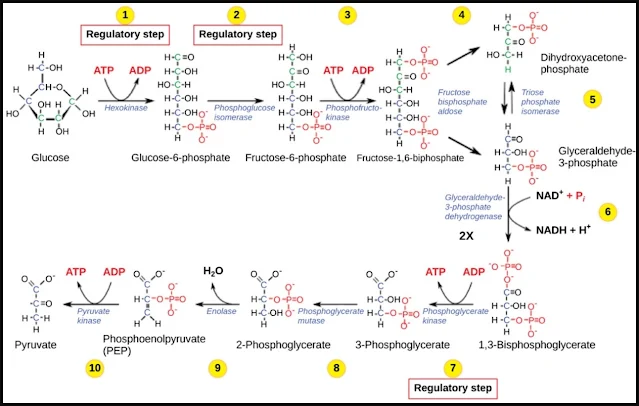INTRODUCTION: In the pathway of glycolysis, glucose is split into two 3-carbon pyruvate molecules under aerobic conditions; or lactate under anaerobic conditions, along with production of a small quantity of energy. All the reaction steps take place in the cytoplasm. Pyruvate: Lactate
SIGNIFICANCE OF THE GLYCOLYSIS PATHWAY:
1) It is the only pathway that is taking place in all the cells of the body.
2) Glycolysis is the only source of energy in erythrocytes.
3) In strenuous exercise, when muscle tissue lacks enough oxygen, anaerobic glycolysis forms the major source of energy for muscles.
4) The glycolytic pathway may be considered as the preliminary step before complete oxidation.
5) The glycolytic pathway provides carbon skeletons for synthesis of non-essential amino acids as well as glycerol part of fat.
6) Most of the reactions of the glycolytic pathway are reversible, which are also used for gluconeogenesis.
GLUCOSE ENTRY INTO CELLS: Glucose transporter-4 (GluT4) transports glucose from the extracellular fluid to muscle cells and adipocytes. This translocase is under the influence of insulin. Insulin In diabetes mellitus, insulin deficiency hinders the entry of glucose into the peripheral cells. Diabetes Mellitus But GluT2 is the transporter in liver cells; it is not under the control of insulin.
STEPS OF GLYCOLYTIC PATHWAY
STEP 1 OF GLYCOLYSIS: Glucose is phosphorylated to glucose-6-phosphate. The enzyme is hexokinase (HK), which splits the ATP into ADP, and the Pi is added on to the glucose. The energy released by the hydrolysis of ATP is utilized for the forward reaction. Hexokinase is a key glycolytic enzyme. Hexokinase catalyses a regulatory step in glycolysis that is irreversible. But this irreversibility is circumvented by another enzyme glucose-6-phosphatase. The phosphorylation of glucose traps it within the cells. Once phosphorylated, glucose-6-phosphate is trapped within the cell and has to be metabolized.
STEP 2 OF GLYCOLYSIS: Glucose-6-phosphate is isomerised to fructose-6-phosphate by phosphohexose isomerase. This is readily reversible.
STEP 3 OF GLYCOLYSIS: Fructose-6-phosphate is further phosphorylated to fructose1,6-bisphosphate. The enzyme is phosphofructokinase. PFK is an allosteric, inducible, regulatory enzyme. It is an important key enzyme of this pathway. This is again an activation process, the energy being derived by hydrolysis of yet another molecule of ATP. This irreversible step is the rate limiting reaction in glycolysis. However, during gluconeogenesis, this step is circumvented by fructose-1,6-bisphosphatase. The steps 1,2 and 3 together are called as the preparatory phase.
STEP 4 OF GLYCOLYSIS: The 6 carbon fructose-1,6-bisphosphate is cleaved into two 3 carbon units; one glyceraldehyde-3-phosphate and another molecule of dihydroxyacetone phosphate (DHAP). Since the backward reaction is an aldol condensation, the enzyme is called aldolase. This reaction is reversible.
STEP 4-A OF GLYCOLYSIS: Dihydroxy acetone phosphate is isomerised to glyceraldehyde-3-phosphate by the enzyme phosphotriose isomerase. Thus net result is that glucose is now cleaved into 2 molecules of glyceraldehyde-3-phosphate. The steps 4 and 4-A are together called the splitting phase. Glycerol portion of the neutral fat can enter into glycolytic or gluconeogenic pathways at this point. Similarly for neutral fat synthesis, glycerol is required which can be derived from glucose through DHAP.
STEP 5 OF GLYCOLYSIS: Glyceraldehyde-3-phosphate is dehydrogenated and simultaneously phosphorylated to 1,3-bisphosphoglycerate (1,3-BPG) with the help of NAD+. The enzyme is glyceraldehyde-3-phosphate dehydrogenase. The product contains a high energy bond. This is a reversible reaction.
STEP 6 OF GLYCOLYSIS: The energy of 1,3-BPG is trapped to synthesize one ATP molecule with the help of bisphosphoglycerate kinase. This is an example of substrate level phosphorylation, where energy is trapped directly from the substrate, without the help of the complicated electron transport chain reactions. When energy is trapped by oxidation of reducing equivalents such as NADH, it is called oxidative phosphorylation. Step 6 is reversible.
STEP 7 OF GLYCOLYSIS: 3-phospho glycerate is isomerized to 2-phosphoglycerate by shifting the phosphate group from 3rd to 2nd carbon atom. The enzyme is phosphogluco mutase. This is a readily reversible reaction.
STEP 8 OF GLYCOLYSIS: 2-phosphoglycerate is converted to phosphoenol pyruvate by the enzyme enolase. One water molecule is removed. A high energy phosphate bond is produced. The reaction is reversible. Enolase requires Mg++, and by removing magnesium ions, fluoride will irreversibly inhibit this enzyme. Thus, fluoride will stop the whole glycolysis. So when taking blood for sugar estimation, fluoride is added to blood. If not, glucose is metabolized by the blood cells, so that lower blood glucose values are obtained.
STEP 9 OF GLYCOLYSIS: Phosphoenol pyruvate (PEP) is dephosphorylated to pyruvate, by pyruvate kinase. First PEP is made into a transient intermediary of enol pyruvate; which is spontaneously isomerized into keto pyruvate, the stable form of pyruvate. One mole of ATP is generated during this reaction. This is again an example of substrate level phosphorylation. The pyruvate kinase is a key glycolytic enzyme. This step is irreversible.
STEP 10 OF GLYCOLYSIS: In anaerobic condition, pyruvate is reduced to lactate by lactate dehydrogenase (LDH).
RELATED;
2. GLUCAGON
3. GLYCOGEN
4. PYRUVATE
5. LACTATE













No comments:
Post a Comment